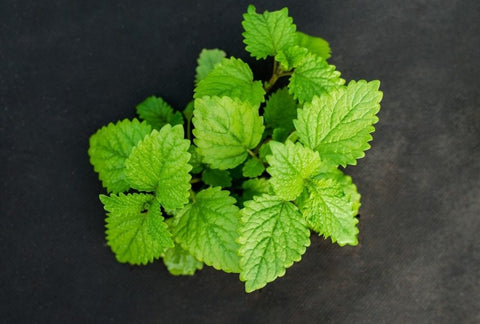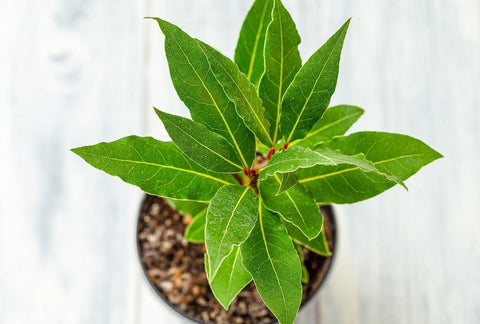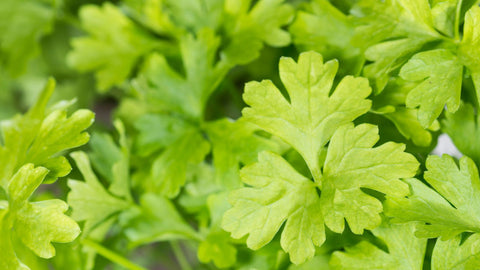Add lemon balm to your water for a refreshing way to stay hydrated. It is also great in homemade tea to improve digestion and sleep quality.

Timing
Sprouts in 2 weeks. Harvest from Month 3+ on.

Part sun
Equivalent of 5+ hours of direct sun [DLI of 15+ mol/m²/day].

Care
Beginner friendly. You’ll sprout, thin, prune, and harvest.
How to Grow Lemon Balm: Best Lemon Balm Varieties to Grow Inside
The first factor to consider when answering the question about how to grow lemon balm is its variety. There are many different varieties of the lemon balm plant. The most popular ones are listed below and explained why we recommend them.
Citronella
It has a very soothing scent to it and is one of the most flavorful varieties available. It also acts as an effective mosquito repellant.
AmazonVariegated
This plant has a strong mint flavor and is widely used in cooking dishes and aromatherapy.
Hooks Green HerbsLimonella
This variety is the most fragrant of all the variations of lemon balm. The leaves of this plant are used in salads or soups.
Garden Seeds MarketLemon Balm Care Indoors: Best Setup for Lemon Balm Plants
You’ll need:
Planter:
Ceramic Self Watering Planter (preferred) or pot that is at least 6″ / 1 quart.
Soil:
Standard Potting Mix
Plant Food:
At the start: Balanced Blend. This should be equal parts nitrogen, phosphorus, and potassium (with NPK numbers like 10-10-10). Ongoing: Herb Blend. This should be high in nitrogen (with NPK numbers like 10-5-5).
Grow Light:
A strong grow light that can give the equivalent of 5+ hours of direct sun [DLI of 15+ mol/m²/day].
Jump to: Our product recommendations
Lemon Balm Care Indoors: Preparing your Planter & Watering Schedule for Lemon Balm
To care for lemon balm indoors, make sure that lemon balm plants are planted in moist soil conditions. If the soil dries out completely the roots will die back and it will be tough for the plant to recover. On the other hand, if the roots are exposed to standing water for too long, they can rot.
A Ceramic Self Watering Planter filled with a standard potting mix self-regulates to keep the soil at consistent moisture for your plant to thrive (and no watering guesswork for you).
To set one up:

- Fill up the planter with dry soil from the bag, gently tamping down the top.
- Dump the soil into a large mixing bowl and add water until the soil is moist, but not sopping wet (about ½ Cup).
- Mix in 1 tablespoon of the Balanced Blend Plant Food.
If you are using a regular pot instead, it should be a little bit bigger (at least 6″ / 1 quart and will need drainage holes to prevent it from being overwatered. Let the top of the soil dry out between watering.
Starting your Lemon Balm: Seed vs Cutting vs Nursery Plant
New Lemon Balm plants can be started from seed, propagated from an established plant, or purchased live at many garden centers. We prefer to sprout from seed or propagate from a stem cutting, as it results in plants that are adapted to your growing conditions and limit the chances that you accidentally bring home pests.
How to Plant Lemon Balm Seeds

Lemon Balm grows quickly from seed. Plant 1 site in a 6″ / 1-quart container. In larger containers, space sites 4″ apart. For each site press 2 seeds into the surface. Keep the soil warm (65-80°F, ideally 70°F). Sprouts typically appear in 10 days but can be as quick as 7 days or as long as 14 days depending on your conditions. Don’t cover the seeds as light helps them sprout. To speed things up, you can soak them in water for 12-24 hours before planting.
Propagating Lemon Balm: How to Clone from a Stem Cutting

If you’ve already got a Lemon Balm plant you love (or a friend does!), you can easily “clone” it with just sharp scissors and a clean glass of water. First, cut a couple of 6” shoots of new growth (avoid anything woody). Next, remove the lower leaves, so the bottom half is just stem. Place in a glass of 3” of water, making sure the cut leaf spots are underwater. Place the glass on a bright windowsill and change the water every few days. In a couple of weeks, roots should emerge and you can transplant them into your container. While using additional rooting hormones won’t hurt, it’s not necessary with Lemon Balm plants.
- Cut 6” section of new growth.
- Remove leaves halfway and place them in the water on a sunny window sill.
- Wait 7-14 days for a few ½ inch roots to form and carefully transplant into their final container.
How to Transplant Lemon Balm Sprouts

Live starter plants, in this case, lemon balm sprouts or plants, give you a big jump start on your first harvest. When you’re in a garden center, pick the bushiest plant available (tall and lanky ones will be weak growers) and give it a good inspection for pests. Leaves should be dark green without holes, spots, or curled edges. A best practice is to actually “quarantine” your plant for about a week after bringing it home to make sure it’s free and clear of ride-on pests.
Ensuring it’s pest and disease-free, it’s time to transplant your seedling into its final home.
- Remove some soil from its final planter – leaving enough space for the bottom of the seedling to be just higher than the soil surface.
- Hold on to the base of the stem with one hand, and turn the pot over while gently pulling the seedling. Giving the pot a few squeezes can help dislodge it.
- Place in its final container and fill around it with soil so that it’s tight, but not compacted.
Where to Grow Your Lemon Balm Plants
Like all edible plants, Lemon Balm plants need lots of light to grow and develop good flavor. Sunlight is excellent for plant growth (and free!) and you might be lucky enough to have a spot that’s got the 5+ hours of direct sun they need. Even with a bright window, it’s unlikely that you’ll have enough natural light in the winter so we recommend a grow light for anyone who wants a constant supply of flavorful produce. For an introduction to grow lights, head over to our post on grow lights for indoor gardeners. We’ve also got a buying guide for screw-in types, but to keep things simple in this guide, we’ll just provide directions for the 24W Screw-in Bulb by Sansi, which we think is a good middle-of-the-road option.

How bright should your grow light be?
Lemon Balm sprouts or plants need the equivalent of 5+ hours of direct sunlight [DLI of 15+ mol/m²/day] to grow their best. In order to provide an equivalent amount with a grow light, it needs to be pretty bright! The 24W Sansi bulb should be placed 6 inches away from the top of the plant. This will give your PPFD (the standard measure of brightness) of 500 μmol/m²/s.
How many hours per day do your Lemon Balm plants need under a grow light?
Lemon Balm plants are known as “long-day” plants. When they sense over 12 hours of light per day, they’ll start the end of their lifecycle and work on making seeds. We want to keep them in an earlier stage so we can keep harvesting the leaves, so we recommend setting up a timer to leave it on for only 10 hours per day.
Extend your harvest by keeping the temperatures cool
Lemon Balm is known as a “cool weather crop.” If it senses warming temperatures it will “bolt” – send up flowers and become bitter in the process. Where you plant them can have some effect on the temperature – lower positions on a growing rack, ceramic planters, and hydroponics with air bubblers tend to run cooler. It’s best to avoid windows that get really hot (like bay windows).
Week 2: Check for Sprouts
You could see seedlings in as little as 7 days (though 10 days is more typical). If it’s been 14 days and you still don’t have any sprouts, it’s likely that your setup is too cold.
Week 4: Thin Your Seedlings

Thin your planter to only have 1 seedling per site – leaving the largest plant. If you are using the recommended planter (at least 6″ / 1 quart), this will mean you’ve got 1 plant after thinning. By getting rid of the smaller seedlings, you’re allowing the biggest and strongest one to flourish by reducing its competition for water, food, and space.
If your seedlings are under 1 inch, stretching out, or folding over, it’s likely that they don’t have quite enough light.
Month 2: How to Prune Lemon Balm Plants

Once your Lemon Balm plant has 3 sets of mature leaves, you’re ready for your prune. Cut off the top set of mature leaves, leaving the bottom two (it’s best to cut right above the pair of leaves you’re keeping on the plant). Once these branches grow out (and each has a few sets of their own leaves), you can cut the tip – just as you did with the main stem. At this point, your plant will be fairly well shaped, so hone your inner Bonsai master and use your thinning and heading cuts to harvest and shape your herbs as you go.
Month 3+: How to Harvest Lemon Balm
As your lemon balm continues to grow, keep harvesting to encourage growth. If you only want a couple of leaves, pick leaves where new ones are emerging at the base. For a bigger harvest, cut one of the stems directly. You shouldn’t harvest more than 1⁄3 of the plant at a time.
Year 10+: End of Life
Lemon balm can live for a very long time if the conditions are right. If you live somewhere with colder winters and are growing outside, be sure to bring your lemon balm in before the temperatures drop.
Shop This Blog
The right supplies can take the guesswork out of caring for your plants – and turn care from a daily to weekly routine. Through our grow tests, we’ve found these products to produce the best indoor Lemon Balm (and also have simple maintenance). Plants are adaptable and can grow in many different conditions, so they are by no means necessary if you already have other supplies.
Best Containers for Lemon Balm: Ceramic Self Watering Planters
Plants thrive on consistent moisture but can suffer if they’re waterlogged. A semi-porous ceramic self regulates ideal conditions. Our favorite is the COSWIP planter. Runner up is XS Self Watering Planter by Wet Pot.
Best Soil for Lemon Balm: Standard Potting Mix
Lemon Balm likes a rich and moist root zone – so you are best off with a standard potting mix – we like this Potting Mix by Rosy Soil.
Best Nutrients for Lemon Balm: Balanced Blend followed by Herb & Lettuce Blend
Lemon Balm likes to start with nutrients that are equal parts nitrogen, phosphorus, and potassium (with NPK numbers like 10-10-10). For this Balanced Blend we recommend: Dr Earth All Purpose.
Once they are growing, it’s better to use plant food that is high in nitrogen (with NPK numbers like 10-5-5). For this Herb Blend, we recommend: Joyful Dirt All Purpose.
Best Light for Lemon Balm: DIY or Soltech
There is a very small chance that you have the bright windows needed to grow these without a grow light. If you are looking for a higher-end option – we love the Aspect Light by Soltech. For a more affordable option, a DIY setup using a 24W Screw-in Bulb by Sansi with a Clamp Light and Mechanical Timer works well too. Check out our complete guide on a DIY setup for less than $40 or our buying guide for screw-in bulbs.








There are no comments for this article. Be the first one to leave a message!